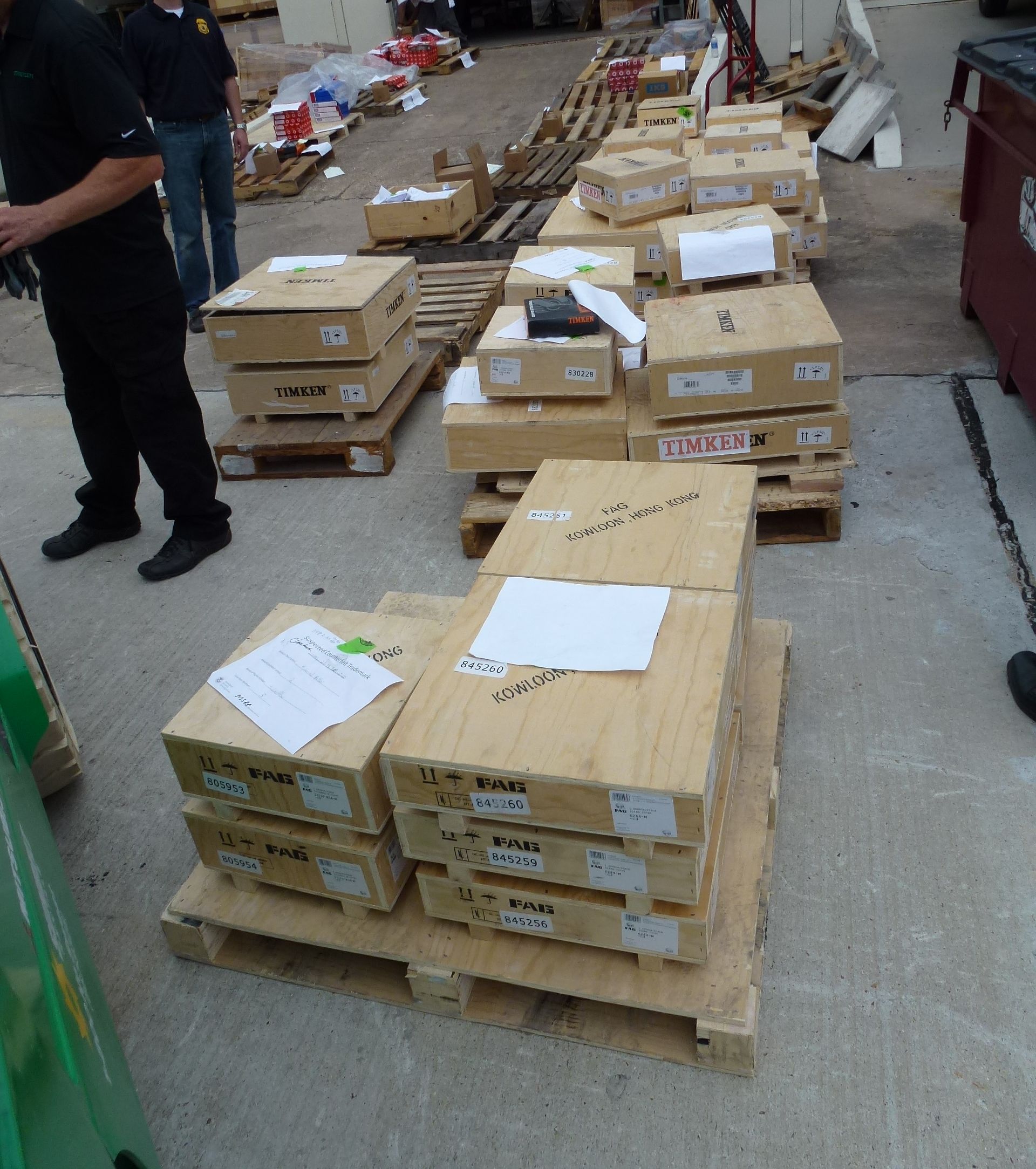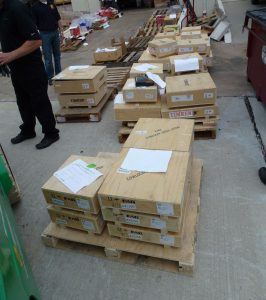
Bearing Witness – Ten industry tips on how to avoid counterfeit bearings
December 21, 2017 | By Carroll McCormick

 A quick internet search will yield plenty of hits about seizures of thousands and millions of counterfeit bearings. “We’ve estimated in the past that 10 to 15 per cent of the global bearing market is counterfeit bearings. In Canada and the U.S. it is probably two to five per cent of the market,” says Antun Peakovic, Director of IP for The Americas, Schaeffler.
A quick internet search will yield plenty of hits about seizures of thousands and millions of counterfeit bearings. “We’ve estimated in the past that 10 to 15 per cent of the global bearing market is counterfeit bearings. In Canada and the U.S. it is probably two to five per cent of the market,” says Antun Peakovic, Director of IP for The Americas, Schaeffler.
Flaws in counterfeit bearings include the wrong lubricant and missing lubricant ports, the wrong metals and incomplete hardening, contamination with iron filings, incorrect running tolerances and the wrong rolling element size. But because counterfeiters can be very good at their job, non-experts who think they can spot fakes have fools for lawyers, so to speak, and is setting themselves up for catastrophic equipment failures.
To take some of the fool out of fakes, here are 10 tips distilled from interviews with three (genuine) bearing manufacturers.
Tip 1: Buy only from authorized distributors: More than any other piece of advice, bearing manufacturers say to buy bearings only from their authorized distributors. If someone claiming to be an authorized dealer contacts you, take a moment to do a cross check: Go to the bearing manufacturer’s website and see if that authorized dealer is listed there. “But who does that,” laments Clayton Tharp, Brand Protection Manager, SKF Group Brand Protection.
“Fake bearings are not coming through authorized distribution channels. It is almost impossible to happen. The best place to look for an authorized channel is the manufacturer’s website. They list all their authorized distributors. If a distributor is not on the list, call the manufacturer and ask,” says Paul Meo, President and CEO of NTN Bearing Corp. of Canada Ltd.
As for so-called trusted sources, Peakovic comments, “The easiest advice is to go to a trusted source. We say trusted source, because a facility might have a trusted source they have gone to for years, but which may not be an authorized distributor. “Authorized distributors are the trusted source from the manufacturer’s standpoint, as they buy directly from us. You know the product is genuine and the related warranty is available. Otherwise, the warranty (or lack thereof) lies with the seller of the parts. [But] if your trusted source is from China or India, there is a decent chance there is a mix of counterfeit and genuine parts,” Peakovic says.
Tharp adds, “Half my work is going to companies and telling them to buy from our trusted sources.”
Tip 2: Believe it: fake bearings are everywhere. “Most customers are not aware that someone would counterfeit something like a bearing. They think usually of watches, handbags … They don’t realize how big it is and how much of the market in the world has counterfeit bearings,” Tharp says.
“Every type of bearing has been counterfeited, from minute needle bearings to two-foot diameter bearings,” Peakovic adds.
Don’t bother looking for a catalogue of what to look for in a fake bearing or package. Why? “We don’t want to train counterfeiters on how to improve their products. We did once issue a guide to key marking errors, and within two months we saw the same guide in a counterfeiters marketing product,” Peakovic says.
Tip 3: Beware emails bearing gifts. “I get questionable emails every day from people offering to sell me bearings from outside of the Americas,” Meo says. The likelihood that any of these emails are from legitimate distributors appears to be slim. As a first cut, Meo suggests, “If you get an email that is not from your trading region, ignore it.” If it is from Lower Bombaria, say, be wary. But if it is from North America, it is more likely to be a legitimate channel.
Be sure your company is aware that counterfeiters use emails to suck people in. Peakovic advises, “Make sure you have guidelines in place for their purchase; for example, don’t buy from random email solicitors, and [ensure] that certificates of origin are reliable.”
Tip 4: The Internet is not your friend. While the Internet can quickly take you to bearing manufacturers’ websites and their list of authorized distributors, it can just as easily lead you to counterfeiters’ websites and a burn. “Counterfeit manufactures selling on the [Internet] regularly attempt to represent themselves as an authorized seller of the product,” Meo says.
“If you start looking around the web, and google SKF, you will get tens of thousands of hits of places to buy SKF,” Tharp says. Instead of randomly thrashing around on the internet, Tharp has this counsel: “You should have gone to <skf.com> if you are looking for a site to buy from. Go to the left side: “find a distributor,” for a list of authorized distributors. If people would buy from an authorized distributor, this is the way to avoid counterfeit bearings.”
Tip 5: Counterfeits will fool you. “People think that counterfeit products look shabby, that the box will be messed up and the bearing will look bad. But we always tell people that an untrained person cannot tell the difference between a genuine and a counterfeit bearing. I always warn people not to try and tell the difference. A guy with 30 years of experience – ‘I’ve been handling SKF all my life’ – they would not be able to tell the difference,” Tharp says.
A counterfeit brand, logo or bearing may not look right, but assume that they will be good enough to fool you. “Part of this issue is not just reproducing the bearings themselves, but [counterfeiters] getting more sophisticated about [reproducing] a manufacturer’s packaging,” says Marcus Wickert, Director of Engineering, NTN Bearing Corp. of Canada Ltd.
Tip 6: Beware of hot deals and regular deals. A standard piece of advice trotted out as a sure-fire telltale is that if the price is too good to be true, it is likely to be a fake. But counterfeiters, crooked they may be, are not slow learners. “Counterfeiters figured out that if they sell bearings really cheap, people will wonder. So, they will sell bearings at near-regular prices to eliminate suspicion – a bit cheaper, but in the same price range,” Tharp counsels.
Tip 7: Certificates of authenticity aren’t worth the match to burn them. What could be more heartwarming than a lovely, official certificate wrapped around your new bearing? How about a genuine bearing. About certificates, Tharp says, “In some markets, Asian, for example, certificates are perceived as a measure of safety, a comfort sign. In their market a certificate is not necessarily a warning sign. In North America, it is a warning sign.
“Of course, paper documents like that are the easiest to forge. Part of our verification is we tell our customers to send us their verification certificates. I received two this week. One from Guatemala, one from Vietnam. You won’t find a certificate in a genuine SKF box.”
Tip 8: When in doubt, ask the manufacturer. Manufacturers are making more sophisticated packaging, with special markings, like currency, and even holograms. “Another initiative that NTN is taking, is that we are introducing hologram technology on our boxes that cannot be easily reproduced by counterfeiters. NTN is on the verge of launching technology where a distributor or end user can validate whether it is a fake bearing,” Meo says.
SKF has a smart phone app, called SKF Authenticate, that makes it easy for buyers to get an expert assessment of their bearing purchase. Launch the app, shoot photos of the sales slip, box and bearing, supply some supporting information about you, and hit send. SKF will almost always reply within 24 hours, Tharp says. “We do thousands of verifications a year.”
Be sure to screw on your photographer’s hat, though: Shots must be in focus, and don’t be stingy. “The more pictures the better. If you can take pictures of all six sides of the box, good. Take overview picture of the bearing, and close ups of any markings,” Tharp stresses.
Peakovic says, “On our own bearings we have a data matrix code, an individual code for each bearing.” On the Schaeffler website is a downloadable app, called Precision Desk, which, according to Schaeffler, “… enables users to verify the authenticity of rolling bearings marked with a data matrix code. A check is made by simply scanning the data matrix code on the bearing or on the bearing packaging.”
Tip 9: Get personal with your distributors and manufacturers. “In our industry, there has been a departure of tacit knowledge at the end user with the boomer retirement, [people] who have been interacting with manufacturers and authorized distributors – the old guy who has been dealing with a distributor for 30 years. The risk to buying from a questionable source increases exponentially, as Gen-X and millenniums today prefer Internet-based research to support their immediate needs, relying less on the knowledge and service relationship between manufacturer and distributor and end user,” Meo says.
Tip 10: Beware aftermarket assemblies. Complete aftermarket assembly components may be at risk. If they are knockoffs, they may have been built using counterfeit bearings or other assembly components. The risk is high enough that Wickert even made reference to a company that, when it buys gearboxes, they replace all the bearings because they are sure of their origin and make.
“[Genuine] aftermarket assemblies will come through authorized channels. If you stray outside these channels [you are at risk],” Meo says.
This article is published in the April 2017 issue of Machinery and Equipment MRO.
Montreal-based Carroll McCormick is the award-winning senior contributing editor for Machinery and Equipment MRO.
